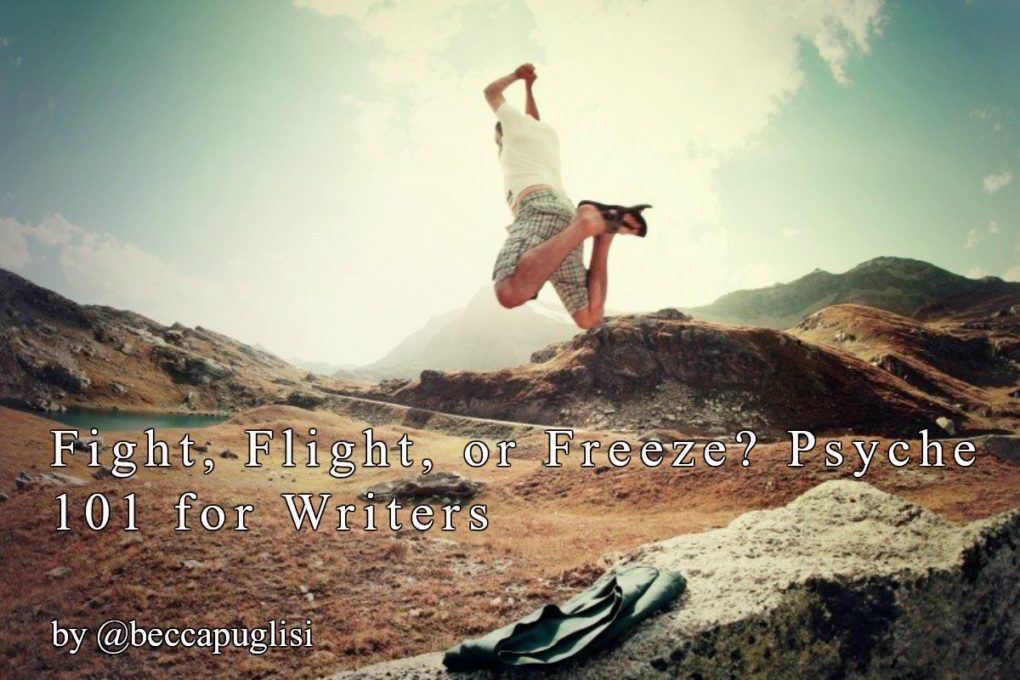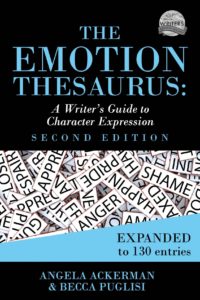by Becca Puglisi, @beccapuglisi
Fight or flight.
I think we’ve all heard this phrase. It refers to the way each person is hard-wired to respond to real or perceived danger. Psychologists have recently added another option, giving us three ways we might respond to threats: we fight back, we flee, or we freeze up. This happens in life-or-death situations, but it also occurs on a smaller scale whenever we feel endangered:
- At the mall, when you see someone who mistreated you in the past
- At work, when the boss criticizes your work
- At a party, when a friendly conversation takes an uncomfortable turn
- At school, when you hear an ugly rumor someone has started about you
So whether the situation is potentially fatal or just a little threatening, you’re going to respond in one of those three ways. What does that look like? Here are few possibilities that cover a range of intensity:
Fight Responses
Confronting the offending party
Invading their personal space
Verbally or physically attacking the person
Seeking revenge
Flight Responses
Subtly changing the subject during a conversation
Avoiding certain people, places, or topics
Literally fleeing—moving away from the source of one’s discomfort
Laughing it off; acting like there is no threat
Freeze Responses
Not answering when one is addressed
Stumbling to a halt
Feeling paralyzed, as if one is physically unable to move
Squeezing the eyes shut and going still
This is obviously just a sampling; more responses can be found for specific emotions in the Second Edition of The Emotion Thesaurus.
Because this is how we react to real or perceived danger as human beings, it’s important to know which way are characters will lean. Figuring out their fight, flight, or freeze tendency early on can help in a number of ways.
It Provides Characterization
While every character’s specific response to threats is going to be unique, they will each have a general tendency toward one of the three Fs. We need to know these tendencies so we can write our cast members consistently. This is especially important for main characters—protagonists, villains, love interests, etc.—because they’ll have more screen time; more things will be happening to them, providing more opportunities for reactions.
So before you start writing, ask yourself: Is this character more likely to fight, flee, or freeze in a threatening situation? When that scenario arises in the story, you’ll know their general kind of response. Then you can individualize the reaction to fit your character.
It Can Serve Your Story
Threatening scenarios—even small-scale ones—are tension builders, so hopefully you’ll include many of them in your story. But sometimes you’re looking for a certain kind of response: you need someone to run away or do nothing (avoiding the problem and allowing it to worsen) or go on the attack (causing more problems and making things more difficult).
If you’ve done your research and it’s time to start writing scenes, you can then conduct a casting call: use the characters who will serve your story best in that moment. If a scene needs conflict but your protagonist tends to shy away from trouble, team them up with a friend, co-worker, or rival who is impulsive or thrives on confrontation. If you don’t want to kill the tension by resolving a problem too quickly, pair a fighter with someone who’s reluctant to face conflict.
Each scene needs different things. The more you know about your characters beforehand, the better equipped you‘ll be to figure out who should be involved in various parts of the story.
It Provides a Clue to Hidden Emotion
Let’s face it: none of us are 100% honest. We temper our words to accommodate the people around us. We hide our true opinions. We only show “safe” emotions—the ones that don’t make us feel vulnerable in the moment. This leads to us often hiding what we really feel.
Characters should do the same. When they feel threatened or vulnerable, they’ll try to hide that by conveying a false emotion.
Writing hidden emotion can be tricky because you have to show the false emotion to the rest of the cast while revealing the real emotion to the reader. There are a number of ways to effectively get this information across, and one of them is through the fight-flight-or-freeze response. Consider the following example from The Emotional Wound Thesaurus:
Sara poured sugar in her coffee and stirred, the clink of the spoon melodic against the cozy murmur of voices from neighboring tables. Sunlit, with a breeze coming off the water, the outdoor café was so peaceful this time of day—before the high school kids took it over.
“I like this place,” Mom said, blowing on her tea. “It reminds me of where I used to go as a girl.”
Sara smiled and leaned back, the wooden seat slats warming her skin. “The place with the éclairs?”
“Mmmm. That’s the one.” Mom took a sip, then her eyebrows shot up. “Oh, a friend of yours showed up at Mass on Sunday. Annemarie? Marybeth?” She shook her head. “Something with two names.”
Sara jerked, dousing her hand in hot coffee. She set the cup down with a clatter and shrugged. Don’t know who you mean.
“My memory these days—I swear.” Mom sighed. “She said you worked together last summer during your internship.”
Sara met her mother’s gaze, which showed curiosity instead of the horror that would be there if she knew the truth.
“Doesn’t ring a bell.” Sara grabbed the check. “’I’ll get this. Hey, how’s your yoga class going?”
Here we see signs of a flight response. When Sara’s mom mentions the girl from her past, Sara immediately goes on high alert. She doesn’t show this; overtly, she acts as if nothing has changed. So how do we know she’s upset? She gives the barest reaction possible: a shrug. No verbal reply at all. You can almost hear Sara silently begging her mom to let it go. When she doesn’t, Sara’s flight response escalates in the form of her wrapping up their outing and changing the subject.
There are other clues that Sara is hiding her emotion, such as the initial involuntary jerk, the clarity of her thoughts, and the overall change in mood (from a calm, casual lunch date to one charged with tension). When you combine her flight response with these other signals, it becomes clear that she’s not being forthright.
As you can see, the fight-flight-or-freeze response is rooted in real-life behavior, and knowing which tendency is most likely for our characters can add a sense of realism and authenticity to our writing. So let me encourage you to take the time to figure this out, and you’ll reap the benefits in stronger characterization, well-balanced scenes, and deeper, more layered emotional responses.
Which tendencies do you see with your current cast? A mix is typically a good idea, adding variety and allowing you to plug each character into different scenes to achieve the best result.
 Becca Puglisi is an international speaker, writing coach, and author of bestselling books for writers—including her latest publication: a second edition of The Emotion Thesaurus, an updated and expanded version of the original volume. Her books are available in multiple languages, are sourced by US universities, and are used by novelists, screenwriters, editors, and psychologists around the world. She is passionate about learning and sharing her knowledge with others through her Writers Helping Writers blog and via One Stop For Writers—a powerhouse online library created to help writers elevate their storytelling.
Becca Puglisi is an international speaker, writing coach, and author of bestselling books for writers—including her latest publication: a second edition of The Emotion Thesaurus, an updated and expanded version of the original volume. Her books are available in multiple languages, are sourced by US universities, and are used by novelists, screenwriters, editors, and psychologists around the world. She is passionate about learning and sharing her knowledge with others through her Writers Helping Writers blog and via One Stop For Writers—a powerhouse online library created to help writers elevate their storytelling.
Photo on Visual hunt


Showing false emotions while letting the reader know the real ones is tricky sometimes.
Never thought about the freeze option. Deer in headlights do it very well though.
They sure do! Thanks for the post today, Becca!
This was a fun one to write. Thanks very much for hosting me!
I never thought of this one, either, until Angela and I started editing the second edition of The Emotion Thesaurus. That’s when we realized that a third option had been added. I definitely think it applies :).
What an interesting way to look at characters and character development. Understanding how people tend to react in certain situations is really helpful in adding those layers to a story. Thanks for the insight.
I’m finding that there are SO many ways to individualize our character’s response to what we throw at them. Clichéd characters really could become a thing of the past if we take the time to study them and understand who they are on these micro-levels.
Some people are born fighters, but I suspect there are a lot more that freeze up in a situation than we realize.
I agree 100%, yet we see the fight response so much more in fiction. Confronting a problem is, I think, more socially acceptable than running away from it; the former is seen as a show of strength while the latter is weak. Which is unfortunate, because unhealthy or untimely confrontation can be as damaging as avoiding a problem.
Like you, I think far more of us tend to flee or freeze than fight; it would be nice to see those responses represented more in fiction.
I hadn’t heard of freezing up as a third option to the fight or flight thing, but that makes sense. It’s certainly an experience I think we’ve all had at some point, and it’s something readers can empathize with… maybe even more so than fighting or fleeing.
I would be interested to know if there is a correlation between people who freeze and “think before acting” types. I would think there would be!
Such a great way to look at characters reactions to surprises and danger. I really liked the example Becca used.
Thanks, Natalie. It’s good to see you!
Great post!
I tend to freeze or fly, but writing characters who fight can be so much fun, too!
Same here!
This is so interesting to read. Thanks for sharing your thoughts!
http://www.ficklemillennial.blogspot.com